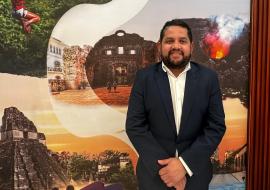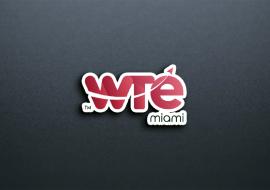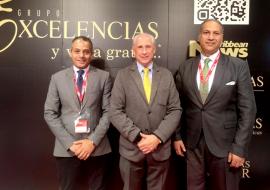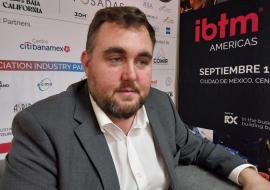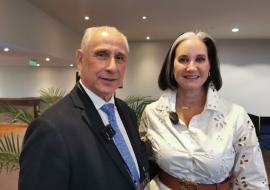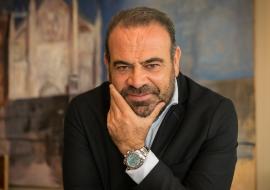Q & A with José R. Méndez of the TSTT Steering Committee
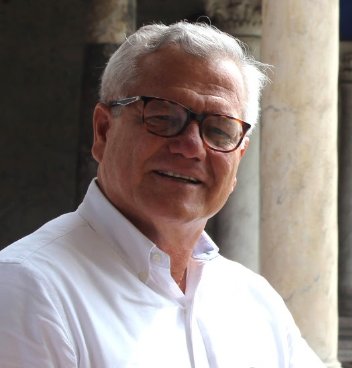
Mr. José Méndez or Pepe Méndez, as all his friends call him, is an entrepreneur, with experience in the management of organisations and projects, he participates in the Master's Programme in Tourism and Cultural Heritage and UNESCO Chair in Cultural Tourism and UNESCO World Heritage Site Management certification.
Executive Director of the Patronato del Rímac and Cite Tecnología e Industrias Creativas (Peru), his great passion, he works to integrate people who aim to mobilise, involve and engage public institutions, private enterprise and individuals to achieve the recovery of civic space, conservation, dissemination and enhancement of tangible and intangible, natural, archaeological, historical and artistic cultural heritage of the Rimac district.
Dear Mr. Méndez, first of all, what is RIMAC?
The Rímac is a traditional district of Lima in Peru, it is part of the Historic Centre and for its characteristics of exceptional value that makes it unique in the world, it was recognised as a World Heritage Site by UNESCO. It preserves the extraordinary richness and diversity of our architectural heritage, its history, traditions, music and gastronomy. An inestimable cultural value that constitutes at the same time a great tourist potential. For 10 years we have been working with the aim of converting the Rímac Historical Centre into the best possible demonstration of Peru's determination to transform the RIMAC into a civic space to live, work and enjoy.
In your opinion, what is the importance of heritage in tourism?
One of the sectors where heritage interacts and impacts most notably is undoubtedly tourism. UNESCO today understands cultural heritage in a broad sense, as both a product and a process that provides societies with a wealth of resources that are inherited from the past, created in the present and passed on to future generations for their benefit. For us, the monumental, historical and cultural heritage of Rimac is a major asset, we want to see it as an economic value to be a trigger for the economic and social development of the citizens of Rimac. Therefore, the economic potential of heritage should not only be seen in terms of its quantity and quality from a cultural point of view, but it is necessary to put it into perspective in terms of its value as a resource for social development and especially for tourism.
What is the importance of cultural heritage for the promotion of cultural tourism?
Cultural Heritage designates an inheritance (tangible or intangible) received by the Rimac community not only to be passed on to future generations, but also to be used, enjoyed and protected by present generations. This fundamental nuance justifies understanding heritage in its double cultural and economic value. Therefore, heritage is the most important resource for the economic development of the community, and this cultural heritage in turn is the element with the greatest capacity to attract cultural tourists. Let us not forget that cultural tourism in the world has managed to adapt successfully to the challenges imposed by the health situation and the changes in the needs and consumption patterns of tourists.
How to promote heritage tourism in places like RIMAC?
The historical and cultural heritage that Rimac treasures is of unique value, and we face problems in the face of the great difficulties involved in preserving this heritage. There is no doubt that cultural heritage generates important economic activities directly related to its identification, protection, conservation, restoration, management and enhancement, but heritage is also related to other activities or products of the economy, especially the broad sector of cultural and creative industries.
This richness of the CCIs is what we are also working on in Rimac, because it is not only about developing containers but also about the creation of content, where the participation of the local population that has to do with creativity and the arts is very important. We are working in different fields of heritage management and promotion: environment, tourism, archaeology, security, urban planning, accessibility, mobility, without forgetting the promotion of the cultural tourism offer and the creative industries as a unique and exceptional value, in order to achieve greater visibility of our product around the world.
What do you think is the current situation of Peruvian heritage and its relationship with tourism?
Peru is considered one of the seven original cultural centres of humanity, the culture of the INKAS. The heritage legacy of the Inkas that history has left throughout the territory of Peru is a very broad and large case, and requires a state policy that we have not yet managed to develop. We have so much, but we do not yet know how much.
This requires not only enormous economic resources, but also human and technical resources. The existence of cultural heritage and intangible culture is not in itself an automatic economic benefit for a territory: it is necessary to provide these assets with economic investment and appropriate cultural and tourism policies so that their management is focused on the generation of social and economic development of the territory, while guaranteeing their conservation and sustainability. Those countries that develop specific cultural state policies achieve a much higher growth in cultural tourism than those that do not apply them.
Given your experience, what is new about the Tourism and Society Think Tank for the tourism industry?
The Tourism and Society Think Tank is made up of professional experts in different areas of tourism and society, regardless of the corporate and institutional positions they represent, and is a great space for reflection, consultancy and advice for professionals, companies and institutions in the tourism industry. It contributes to the development and knowledge of the tourism industry, the types of tourism and the social impact it has. It also analyses tourism trends with the participation of related actors and agents. It also allows the promotion and communication between professionals through professional meetings, publications, interviews and more. Finally, it provides information and points out the risks and opportunities of a sector whose social, economic and cultural impact is of the first order.
Why do you think the TSTT is important for tourist destinations such as RIMAC?
The first thing is that thanks to the TSTT in alliance with PROMPERU, we are promoting a global event in Lima and Tarapoto, with top professionals to reflect and present innovative proposals for the transformation of processes by digitisation in the management of tourism products. The theme is Digitalisation and Innovation for the tourism industry; this puts Rimac in the eye of the world tourism industry. In addition, global investors are being invited to develop projects in Peru and Rimac in particular.
Public-private collaboration is essential for the enhancement of heritage and the tourism industry. How would you define the current situation in Peru?
Collaboration between all the actors in the industry is essential in order to find solutions and strategies that allow the development of sustainable, accessible and innovative tourism, diversifying the tourist offer and enhancing the value of cultural identity while at the same time stimulating tourist flows and creating wealth. In the face of the unprecedented crisis we are experiencing, Peru must accelerate its economic recovery, and cultural heritage is a powerful factor in economic development. Tourism is the largest and fastest growing industry, and its development, success and longevity are of importance to the economy. That is why we must work to regain market confidence, innovate the value proposition, extend digitalisation to the entire sector and raise service levels. We must abandon inertia and immediately undertake joint actions by the state, private enterprise, civil society and academia that will serve as the foundations of Peru's tourism transformation. The successful work of the Patronato del Rímac, with academia, the private sector and the state, is a good example of this.
And from the point of view of public-private partnerships, what lines do you think should be considered?
The health crisis has put the administration at the forefront of the recovery. We must act in an agile, rapid and forceful manner in response to the challenges facing tourism activity. It is necessary to harness and build capacity in internal teams and work closely with regional and local administrations, the private sector, communities and citizens. From this perspective, we propose far-reaching actions that will serve as the basis for tourism recovery and transformation. The first is the sustainable digitalisation of the entire ecosystem of Peru's tourism industry. Promote, develop and digitise destinations and also enhance the value of cultural identity products such as gastronomy and handicrafts. The programme seeks to educate and train professionals in the sector in tourism management and the digital literacy of all users. It also works to design new communication and promotion strategies, create digital certification tools for products of cultural identity and collaboration models that favour relations between the public and private sectors.
After a pandemic like the one we have experienced, how can the TSTT, as a group of experts, help to position tourist destinations?
Of course it can, the quality of the group that makes it up, both at management and grassroots level, and the experience and know-how of these is of great value, they have knowledge of the actors and the tourism industry, on the other hand, the independence and the open and participatory nature of all is a strength, as well as the multidisciplinary nature of its members generates multiple institutional and commercial relationships. The TSTT is a space where professionals from different fields can reflect and present innovative proposals to position tourist destinations.
For the last ten years, you have been directing the Patronato RIMAC, where heritage recovery is the basis for social, economic and cultural development. How did you start your work and where are you now?
El Rimac is a cultural utopia, becoming a reality. It is the resilience and undaunted tenacity that has been driving the members of the Patronato del Rimac not to abandon the objective of soon seeing the recovery of the civic space in Rimac. In 2012, a group of citizens with knowledge of the valuable artistic and cultural heritage that the Rímac treasures met with the sole objective of joining forces to prevent the inexorable passage of time and the authorities' negligence from destroying the deteriorated historical legacy. This is how the Patronato came into being. We are firmly committed to recovering the Rímac for Peru and the world. But more importantly, it is for the citizens of Rimac, as it includes the renovation of urban housing, to build a society with pride and a sense of belonging. These projects are of vital importance for the recovery of the Historic Centre, which is part of the Cultural Heritage of Humanity recognised by UNESCO for Lima since 1991.
We want to make a genuine positive difference in people's lives. Today we are in the process of implementing 30 infrastructure projects to recover and enhance the heritage of the Rímac, as well as multiple projects for the economic and social development of the city, cultural and creative industries, and a heritage observatory to ensure its maintenance and sustainability. In less than 4 years Rimac will have changed completely. We can make one of the best cities in the world in Rimac, or at least the best we have been able to create together. It could be said that we have always been disruptors and today the ambition to create, improve and move forward is evident. Personally, I feel compelled to drive change and change the world for the better, we accept the responsibility and embrace it.







